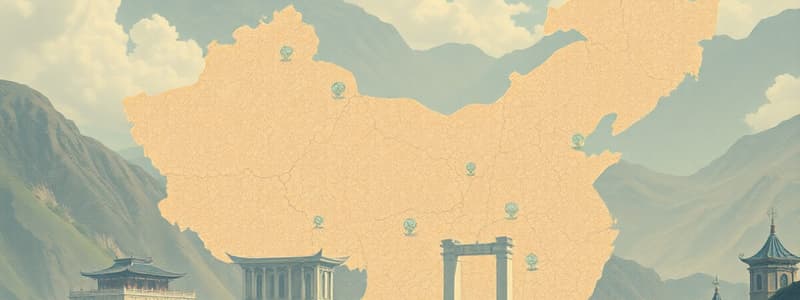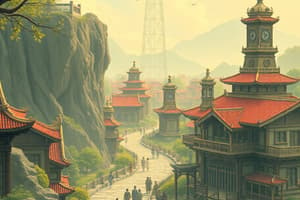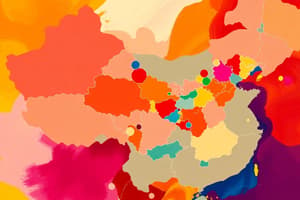Podcast
Questions and Answers
What fraction of the world's population lives in China?
What fraction of the world's population lives in China?
- One out of ten
- One out of three
- One out of four
- One out of five (correct)
The average precipitation in China is over 600 mm per year.
The average precipitation in China is over 600 mm per year.
True (A)
What characteristic of China's geography is mentioned in the text?
What characteristic of China's geography is mentioned in the text?
Much of China is mountainous.
The eastern part of China is often described as __________ while the west is more __________.
The eastern part of China is often described as __________ while the west is more __________.
Match the following regions in China with their characteristics:
Match the following regions in China with their characteristics:
Which of the following cities is NOT mentioned as densely populated?
Which of the following cities is NOT mentioned as densely populated?
The Tibetan Plateau is known as 'the roof of the world.'
The Tibetan Plateau is known as 'the roof of the world.'
What type of landscape predominantly covers the Tibetan Plateau?
What type of landscape predominantly covers the Tibetan Plateau?
The Tibetan Plateau has an elevation of around _____ m.
The Tibetan Plateau has an elevation of around _____ m.
Match the following rivers with their sources:
Match the following rivers with their sources:
Flashcards
East China population density
East China population density
East China has high population density with large cities like Beijing, Shanghai, and Guangzhou.
West China population sparsity
West China population sparsity
West China has low population density due to harsh climate (dry or cold).
Tibet's high altitude
Tibet's high altitude
Tibet is a high-altitude plateau, also known as 'the roof of the world'.
Tibet's landscape
Tibet's landscape
Signup and view all the flashcards
Tibet's river source
Tibet's river source
Signup and view all the flashcards
China's Population
China's Population
Signup and view all the flashcards
Uneven Population Distribution
Uneven Population Distribution
Signup and view all the flashcards
China's Climate
China's Climate
Signup and view all the flashcards
Population Density in China
Population Density in China
Signup and view all the flashcards
China's Mountainous Terrain
China's Mountainous Terrain
Signup and view all the flashcards
Study Notes
China: Population and Space
- China has 1.4 billion people
- Population distribution is uneven, most in the east
- Eastern areas are densely populated with big cities (Beijing, Shanghai, Guangzhou)
- Western areas are sparsely populated due to dry and high (cold) conditions
- Average precipitation in China is over 600mm, but varies greatly, ranging from 1,000-2,000mm in the southeast to less than 50mm in the northwest
- The Tibetan Plateau is very high (4,500m) and is mostly a tundra, always frozen, except in summer
- This region is the source for China's major rivers
- China's relief is like a staircase, with three major levels
Population Policy
- The Chinese government has implemented policies to change population size and distribution.
- From 1979 to 2015, one child per family was the strict policy; fines were imposed for violations
- This resulted in a decreased birth rate, but created a growing elderly population
- Life expectancy increased from 41 years in 1955 to 76.5 years in 2018
- The policy was adjusted to allow two children in 2015.
- Efforts to spread population distribution are ongoing, enticing people to move to the less populated west with job opportunities or housing
Ethnic Minorities
- The Han Chinese are the majority group (majority of population, culture, language) located in the east
- There are about 100 million Chinese belonging to ethnic minorities, who live in the less populated western regions
- Sinicization policy aims to make the minority areas more Chinese, encouraging Han Chinese migration to these regions
- This policy sometimes clashes with minority cultures (e.g., Uyghurs), as it is considered a forceful cultural imposition. The Han Chinese often get the best jobs and highest pay
China: From Copying to Innovating
- China was a relatively poor country for a long time
- But in the past forty years, China's economy has rapidly transformed, becoming the second-largest in the world.
- The one-party system remains, but the country's business sector has opened to foreign companies
- Initially, this occurred in coastal regions, extending to inland areas later
- Large international companies operate alongside Chinese companies, competing in the tech industry
- Chinese tech companies have emerged, like Tencent with its WeChat app (with over 1 billion users)
- Large-scale migration and urbanization has occurred within China
- China's industry is evolving from simply producing products to becoming an innovator
Migration and Urbanization
- In 1980, 80% of the Chinese people lived in rural areas
- Now nearly 60% of the population lives in cities
- The number of cities with over one million people has increased from 15 to 100
- Urbanization is increasing rapidly
- Mass migration from the countryside to cities is influenced by factors like mechanization of agriculture and higher wages in the city, along with attractions of a Western lifestyle
- Many are attracted to the cities for work, leading to a significant population shift to urban areas and significant wealth difference between rural and urban China
- A substantial amount of China's populace (around 250 million) is unregistered; these people have no official legal rights to live and work in the larger cities.
Water in China
- Water is unevenly distributed, with the south being wet and the north dry, affecting water management and availability.
- The Yangtze River is 6,300km long, originating in the wet south; major flooding usually occurs in spring and summer, which is exacerbated by deforestation
- The Three Gorges Dam was built to control flooding, providing hydroelectricity and irrigation water, but also displacing people
- The Huang He (Yellow River), almost 5,500km long, is located in the north (dry); the river is called yellow due to the loess (fine particles) it carries, which impacts water quality and creates water shortage in the north
- China is experiencing issues of water shortage in the north and actively working on policies and projects that redirect water from wetter to drier lands (South to North Water Diversion Project).
Studying That Suits You
Use AI to generate personalized quizzes and flashcards to suit your learning preferences.




